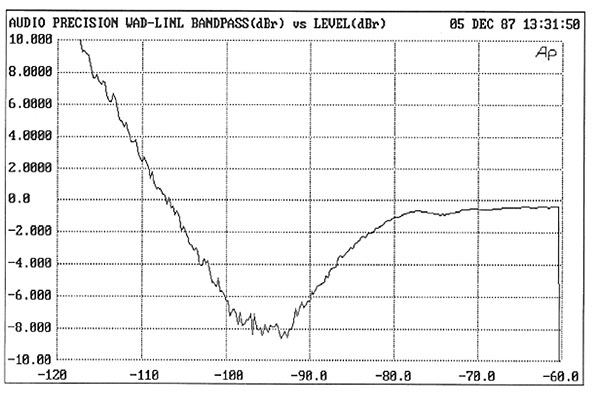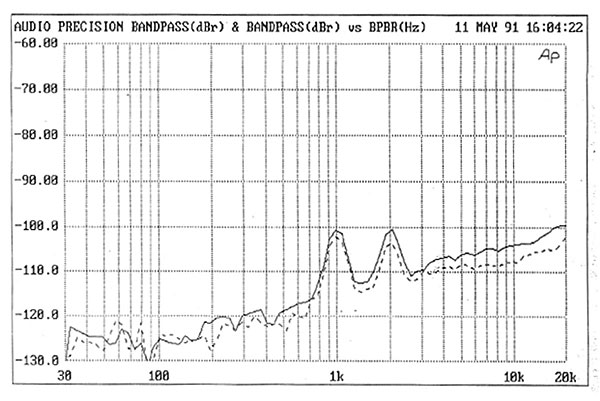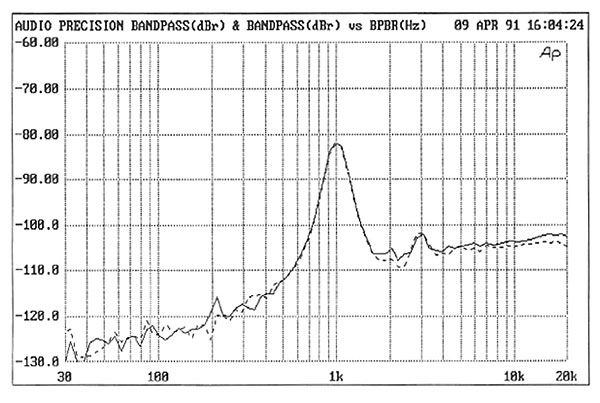| Columns Retired Columns & Blogs |
Wadia Digimaster 2000 Mk.2 digital processors
 During my reviews of digital processors in the past year or so, I've made comparisons with the Wadia 2000 Digital Decoding Computer first reviewed by Arnis Balgalvis in Vol.13 No.1. I've felt that, as good as the 2000 is, other processors—many costing less than the 2000's $8500 price tag—are now superior.
During my reviews of digital processors in the past year or so, I've made comparisons with the Wadia 2000 Digital Decoding Computer first reviewed by Arnis Balgalvis in Vol.13 No.1. I've felt that, as good as the 2000 is, other processors—many costing less than the 2000's $8500 price tag—are now superior.
However, a visiting Wadia representative looked inside our sample and used the word "ancient" to describe its circuitry in relation to current production. In addition, I was never able to audition the 2000 with a glass fiber-optical interface, standard equipment on Wadia's transports. Similarly, the $2000 Wadia X-32 had undergone a minor circuit revision, including the inclusion of the glass optical input. Consequently, a follow-up of these two excellent processors seemed in order.
The latest 2000 features the "Rok Lok" circuit that reportedly reduces jitter in the recovered clock. This circuit is described in detail in my Vol.13 No.8 review of the X-32. Our 2000 also benefited from a new analog output stage called the "Sledgehammer," so named for its ability to drive large amounts of current into even low-impedance loads. Other minor revisions were also made, including reducing the number of boxes to three rather than four: The DigiLink 40, which converts an electrical signal into an optical signal, now has an integral power supply. Owners of transports with glass-fiber output can buy the 2000 without the DigiLink 40, eliminating another box from the system and reducing the 2000's price by $950 in the process. With the new 2000 and a Wadia transport, only two boxes are needed (not including the transport). I found the original 2000's four boxes and myriad connecting cables cumbersome, and welcomed the newer version's greater simplicity.
I listened to the Wadia with the same system described in my reviews in this issue of the Audio Research DAC1 and Wadia WT-3200 transport. On hand for comparison were the DAC1, Theta DSPro Basic, Proceed PDP 2, and Meridian 203 processors.
Starting with the 2000 driven by the WT-3200's glass fiber-optical output, it was immediately apparent that the glass-fiber–driven 2000 was a great improvement over the older version. I was immediately taken by its soundstage resolution and palpability. The impression of instruments existing in space, each surrounded by a "halo" of air, was stunning. There was a unique three-dimensional quality that transported the listener to the musical event. Instruments existed behind one another in the soundstage without interfering with each other. Each thread in the musical fabric was clearly delineated and seemed somehow unattached to the presentation. When I say unattached, I mean that each instrument or voice was presented as an individual entity rather than just another sound imbedded in the rendering. The 2000's ability to throw precise images within a transparent, three-dimensional soundstage was quite spectacular, and unequaled by any other processor I've heard.
Another hallmark of the Wadia processors is their exceptional bass drive and low-frequency dynamics. The 2000 seemed to add another octave of LF extension, and had a remarkable sense of weight and authority in the midbass. The lower octaves were powerful and effortless, infusing music with drive and energy. Music that relies on bass guitar and kick drum as the rhythmic foundation benefited from the 2000's rendering, seeming to better convey the musicians' energy. The excellent rhythm section on Stevie Ray Vaughan's In Step (Epic EK 45024) really came to life through the 2000. Similarly, the 2000 presented the full authority of an orchestra without a sense of effort or strain. Musical climaxes were powerful and dynamic, greatly adding to the musical experience.
The 2000's treble was quite laid-back and gentle, without the forward rendering often heard from digital. Cymbals had a smoothness that made high-volume, long-term listening possible. There was, however, a slight feeling that the 2000 lacked air and top-octave extension, sounding somewhat confined in the extreme treble. It's no secret that the 2000 rolls off the treble in the audio band, being down a full 3dB at 20kHz. Is this rolloff audible? You bet. It no doubt accounts for the smooth treble balance and subjective lack of the openness heard through some other processors. Despite knowing that the 2000 departs from accuracy in the top octave, I did prefer its treble rendering on most recordings.
The midrange was quite smooth, with accurate portrayal of instrumental timbres, but I felt the Audio Research DAC1 and VTL Reference processors were superior in this regard. These two UltraAnalog-based converters, along with the Stax DAC-X1t, have unparalleled liquidity and natural timbres through the mids. Solo piano, in particular, had a round lushness and more natural presentation through the VTL and Audio Research. Although the VTL has less soundstage focus and a bass presentation nowhere close to the 2000, it does have a magical quality in rendering analog-like instrumental textures.
The newest Wadia 2000, driven by the glass fiber-optic interface, is superbly musical and in many ways represents the state of the art of digital playback. It is clearly and dramatically improved over the earlier version auditioned, and when driven by a Wadia transport with glass-fiber output, takes another leap up in musicality over earlier production. The 2000, in my opinion, occupies a solid position toward the top end of Class A in Stereophile's "Recommended Components."
Measurements: The new 2000's measurements are more controversial: it is superbly musical as noted in the auditioning, yet has severe low-level linearity errors. Our original sample (back in December 1989) had the grossest of linearity errors, as seen in fig.7 on p.150 of Vol.13 No.1. The second sample measured for that issue had much better performance, but was still far from ideal. Dick Olsher and I both listened to the original sample and thought it had superb resolution of hall ambience, a quality one wouldn't expect when information actually recorded at –90dB was being reproduced at about –110dB. This experience called into question the correlation between low-level linearity and a processor's presentation of hall ambience and other subtle detail. In addition, a question remained about the 2000: Which sample was representative of off-the-line-production?
Repeating all the original measurements on this very latest unit, I found them to be nearly identical, with the exception of—you guessed it—low-level linearity. Fig.1 shows the departure from linearity, the plot ideally being a straight horizontal line across the graph. Looking at the left channel, which was slightly worse than the right, a signal at –90dB is actually reproduced at –96dB. Furthermore, this unit had nearly identical curves for both channels, indicating that they'd most likely been adjusted to this performance rather than the error being random and the result of drift or the adjustment becoming loose in transit.

Fig.1 Wadia 2000, left-channel departure from linearity, 16-bit data (2dB/vertical div.).
Looking at the spectral content of the 2000 when reproducing a dithered –90.31dB, 1kHz sinewave (fig.2) is more revealing of what is actually going on in the converter. The 1kHz signal can be seen to reach the –100dB horizontal division, confirming the linearity error. However, right next to it, at 2kHz, there is a spurious signal nearly equal in amplitude to the 1kHz tone recorded on the test disc. This 2kHz component is actually part of the 1kHz signal being shifted up in frequency because the DAC is not monotonic. A monotonic DAC increases its analog output when the input digital code increases, and decreases its output when the input digital code decreases. Some of the "rungs" on the DAC's resistor ladder can exhibit non-monotonicity, introducing an error when those steps are exercised.

Fig.2 Wadia 2000, 1/3-octave spectrum with noise and spuriae of dithered 1kHz tone at –90dBFS with 16-bit data (right channel dashed).
This is apparently what is going on in the 2000. Rather than reproducing the three digital levels (0, +1, –1) that represent the –90dB test signal at the appropriate analog output voltages, the DAC is shifting one of the transition levels in the opposite direction, producing the frequency shift seen in fig.2. This accounts for the oddly shaped linearity plot of fig.1: the 1kHz energy isn't really missing as apparently indicated, just shifted up an octave. The Audio Precision System One's bandpass filter ignores the spurious component when making the linearity measurement.
I repeated the spectrum analysis of the 2000, this time using a –80dB test signal. As can be seen in fig.3, the DAC is much better behaved at this higher level.

Fig.3 Wadia 2000, 1/3-octave spectrum with noise and spuriae of dithered 1kHz tone at –80.77dBFS with 16-bit data (right channel dashed).
A possible explanation for why the 2000 seems to have linearity problems is the method Wadia uses to achieve the high "oversampling" rate. I won't go into the technical description here—it can be found in the X-32 review—but suffice it to say that each channel uses four DACs. Normally, a DAC has a Most Significant Bit (MSB) trimmer adjustment next to it that allows the value of the MSB to be adjusted so that its value is one quantization step above the combined value of the lower 15 bits (in a 16-bit converter). This assures that, when the code transition from 1111111111111111 to 0000000000000000 occurs, there isn't a disproportionate jump in the analog output signal's amplitude. This code transition occurs at the zero crossing point of the analog signal, where low-level musical information lies.
The 2000, however, uses a single MSB trimmer for all four DACs. Unless the four DACs have virtually identical performance, setting the MSB trimmer will be a compromise at best. I strongly suspect that this is why the 2000 has linearity problems: one or more of the DACs is non-monotonic with the MSB adjustment where it is. Trimming each of the DACs individually would solve the problem.
Having said all that, however, I'm at a loss to explain the fact that the D/A converter having the worst measured low-level performance is also the one that, in my experience, also has the finest resolution of such low-level musical detail as spatial cues and hall ambience. Musical performance is always more important than measurements, but it is still worrisome that there seems to be an inverse relationship in the 2000 between what one would intuitively think would have a direct positive correlation: low-level linearity and resolution of hall ambience.
At any rate, I'm not going to let my knowledge of the 2000's linearity interfere with the extraordinarily musical experiences it provides. In addition, this technical analysis and criticism should not discourage anyone from buying a Wadia 2000. The bottom line is that its digital playback is, in many ways, the most musical and enjoyable currently available. When listening to the 2000 and the music begins to flow, I can assure you that the last thing on my mind is monotonicity, MSB trimmers, and code transitions.—Robert Harley
Footnote 1: The MLSSA signal generator has an output impedance of 75 ohms, so early HF rolloff due to the cable capacitance will not be a problem with any of the cables under investigation.
Footnote 2: Stereophile is having its Audio Precision System One updated to full dual-domain DSP status this Spring.
- Log in or register to post comments




































